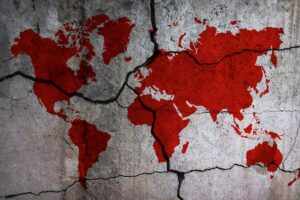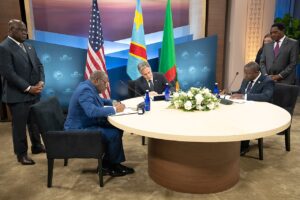The Red cell project
The Red Cell was a small unit created by the CIA after 9/11 to ensure the analytic failure of missing the attacks would never be repeated. It produced short briefs intended to spur out-of-the-box thinking on flawed assumptions and misperceptions about the world, encouraging alternative policy thinking. At another pivotal time of increasing uncertainty, this project is intended as an open-source version, using a similar format to question outmoded mental maps and “strategic empathy” to discern the motives and constraints of other global actors, enhancing the possibility of more effective strategies.
Russia’s war on Ukraine and growing Chinese assertiveness worldwide have cemented Washington’s slide to concentrate U.S. foreign policy on great-power competition — shifting policymakers’ focus from threats coming from fragile states to only those emanating from peer competitors. No doubt the transition was helped along by the trauma of the costly nation-building failures in Iraq and Afghanistan.
However, the threats to global stability from a growing number of fragile states have not evaporated, underscoring the importance of developing new tools for dealing with state breakdown. After all, the growing competition between the United States on the one hand and Russia or China on the other is playing out not just in Europe and East Asia but in the developing world, where state fragility can fuel dangerous opportunities for confrontation. To address fundamental societal weaknesses and vulnerabilities in developing states, an updated toolbox should emphasize economic solutions over military responses. To have an effect and lead to a more comprehensive global peace, such broad-spectrum efforts will require imaginative, comprehensive, and sustained implementation.
A Half-Hearted Approach to “Nation-Building”
Contemporary thinking is that the most significant strategic and military challenge to U.S. national interests will originate from the possibility of large-scale combat operations on Europe’s periphery or in and around the South China Sea. These are genuine and demonstrable strategic concerns and will definitely require the attention of U.S. policymakers. Nonetheless, policymakers’ exclusive preoccupation with these threats seems to have led to the discarding of the post-9/11 era’s focus on stabilization, often derided as “nation-building,” which has played an important role in assuring U.S. national security in the first two decades of this century. Left unchecked, this sharp shift will lead to a repeat of past unforced strategic errors, such as when Washington seemed to suddenly lose interest in the Balkans or hesitated on demonstrating a genuine and sustained willingness to support a realistic alternative to Syrian strongman Bashar al-Assad, leaving U.S. national interests dangerously exposed.
Initially, the U.S. emphasis on stabilization was driven by a fear of terrorists flourishing in failing states. It was also in part a reflection by the world’s remaining superpower of an abundance of ambition following the 1990s’ Balkan wars and guilt over the 1994 Rwandan genocide, which led to retrospective fantasies of the willingness of the international community to guarantee civilian protection. Stabilization efforts covered a range of countries, from Somalia to Iraq to Afghanistan. The challenge quickly became how to handle the aftermath of toppling those governments, which then became an exercise in restoring or imposing governance structures, often in places lacking much democratic heritage or effective and legitimate governing institutions. The dilemma over what was at stake and what to do about it has been at the forefront in the minds of policymakers, as exemplified by statements from the incoming George W. Bush and Barack Obama administrations that they were not in the business of nation-building — only later to embrace ever-more-ambitious amounts of resources to try and accomplish just that.
The path forward also became unclear as divisions emerged on the wisdom and likely effectiveness of surging U.S. military and other resources to fix the pervasive governance deficits in places where U.S. intervention had created a power vacuum. Following extensive domestic debate on a troop surge, the U.S. increased troop levels and then pulled U.S. forces back. The smooth Taliban 2021 takeover in Afghanistan was a verdict of failure in remaking governance. Despite the resources devoted, the goal of building workable governing institutions in a country with such different historical, cultural, and other traditions from those of the U.S. was unattainable. However, there were counterexamples in countries of concern, notably Lebanon and Sierra Leone, where U.S. national interests were less evident and more diffuse. This confirmed the view that a lighter approach, such as in parts of Africa and the Middle East, seemed to be the best option, where limited U.S. national interests tempered Washington’s ambitions.
Shift to Great-Power Competition
But Russia and China had other ideas. For related but distinct reasons, both nations began to increasingly project their influence and challenge the US-led international order. Stark examples include the aggressive operations of the Russian paramilitary organization the Wagner Group, which has offered sustenance to brittle and authoritarian regimes in Africa, while China has flexed its financial, diplomatic, and military muscles across the globe.
Thus, Washington recalibrated yet again — a more measured approach met with the imperative to respond to Moscow’s and Beijing’s more aggressive postures. Washington’s worry started to center more on vulnerable governments in sub-Saharan Africa or across the Pacific Islands that could fall sway to China and Russia. The Biden administration’s alarm about developments in Burkina-Faso and Mali are notable case studies.
Syria has also been a vivid illustration of this shift. When Washington saw the power vacuum resulting from the collapse of Damascus’s control, it responded with stabilization programs in breakaway regions that sought to bypass the Assad regime and support their local governments. But as Russia’s ambition and role grew in the mid-2010s with strengthened military and political assets, U.S. goals for Syria evolved to focus on confronting Moscow’s influence. Some of this effort came in the form of an increased projection of U.S. military power at the expense of the previous practice of direct civic engagement and support for local governance.
Pledging a more comprehensive and coherent approach to China and Russia, President Joe Biden locked in the pivot toward sharp great-power competition and confrontation. There was little partisan disagreement in Washington; this mindset quickly dominated foreign policy thinking at the expense of past policies and practices, including those aimed at enhancing basic governance capabilities in challenging places. Yet, some fealty to a longer-term approach to shoring up stability, including factoring in shifting and emerging threats, such as climate change, remained. In addition, degrees of success seemed to correlate with an approach more realistically calibrated to U.S. national interests. Thus, for example, in the Balkans following U.S. military actions, Washington employed a variety of tools involving support for the rule of law and economic development that represented an active but not dominant role and shifted much of the responsibility to the EU.
Global Fragility Act
A small group in the U.S. Congress labored to eventually enact the Global Fragility Act (GFA) in 2019. This law instructed executive branch agencies, particularly the Department of Defense, State Department, and U.S. Agency for International Development, to develop a long-term comprehensive plan to address instability in a targeted set of countries (and one region) and to do so in collaboration with the work of local, regional, and global actors. The Act explicitly acknowledged the diverse sources of instability, including insurgency, organized crime, mass migration, climate change, and economic hopelessness. It directed U.S. government efforts toward four goals – prevention, stabilization, partnerships, and management — harnessing a range of defense, diplomatic, and development programs to achieve them. Some saw the GFA as a serious attempt to integrate conflict and stabilization thinking into U.S. foreign policy. Others raised questions, despite the inclusion of existing development assistance, concerning the importance of including meaningful economic remedies, such as debt relief.
So far, the Biden administration appears to be taking the Act’s implementation seriously, engaging in concerted and coordinated consultations with international partners as well as the private sector and civil society. The administration is also demonstrating an understanding that the Act can be an investment tool, avoiding much larger security and financial costs down the line and reliance on an overly militarized foreign policy. At the same time, the Act’s tools are insufficient to contend with prevailing economic headwinds, lacking, for example, any provision for confronting accrued debt levels in many less-developed nations. Policymakers’ expectations will need to be kept in check, however, given that the actual resources under the GFA are modest.
Yet, at the same time, money spent does not equate to results realized. The GFA could become the key to a sustainable approach across congressional budget cycles and even presidential administrations that will shape and focus stabilization efforts more in line with considered national interests. This, in turn, could help address a serious pocket of skepticism from many countries about U.S. intentions. If U.S. efforts fall short, on the other hand, the Act could be relegated to being just the latest foreign policy fad, eroding support and sustenance from future administrations and Congresses.
Despite the attraction of U.S. declining global influence as a central thesis of Washington’s foreign policy chattering classes, Washington is still able to manage multiple foreign policy priorities simultaneously. All it takes is a hard-headed, broadly conceived, and continuous assessment of U.S. national interests, coupled with a standing commitment to adhere to a long-term policy. Specifically, this would involve an integrated process that covers strategy development, planning, and execution overlaid with sustained high-level political attention and support. With that in mind, the choice between competing with Russia and China while seeking stability in multiple regions of the world is unnecessary. The two goals are inseparable and reinforce each other.




